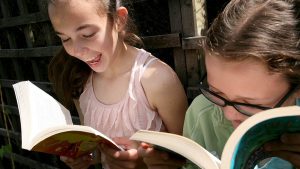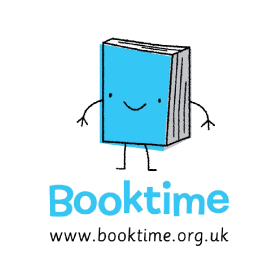The Booktime Project
Background
Booktime was set up by the publishing company Pearson, in association with independent charity Booktrust, to promote the pleasure of reading and encourage parents and carers to read aloud with their children.
The programme was originally piloted in Warwickshire and the London Borough of Southwark in January 2006. Following positive feedback, the programme was scaled out to targeted regions across the UK in October 2006.
In January 2007, the Department for Children, Schools and Families (DCFS) offered to support the expansion of Booktime, enabling every reception aged child in England to receive a book pack. These packs were delivered to schools in partnership with local authorities and library services during the autumn term in 2007. The aim was to give children aged 4 to 5 the gift of an illustrated book (Funnybones, by Allan and Janet Ahlberg) shortly after they started school, to take home to share with family and friends. The books were to be handed out by teachers in a special book bag, along with a guidance booklet for parents and carers on shared reading with their children. In addition, participating schools and libraries in England were given a resource pack to facilitate the children’s enjoyment of the book, containing items such as stickers, badges, and a poster as well as an activity and session ideas booklet.
Findings
The key findings of this evaluation are presented below. Each of these findings has been selected for inclusion in this summary list because it came from more than one of the evidence sources involved in the evaluation. The evidence source for a particular claim is given in parentheses against each claim using the following code:
F – derived from the focus group interviews;
I – derived from the parent/carer interviews;
T – derived from the teacher questionnaires;
P – derived from the parent/carer questionnaires.
- There was an almost unanimous positive reaction to the Booktime pack (bag and book) among teachers, parents/carers and children (F, I, T, P). There is no doubting the delight with which these packs were generally received and many positive comments were made by all stakeholders.
- Some of this positive reaction must, however, be attributed to the Booktime bag rather than the book it contained (F, I, P), although it is quite possible that children’s attraction to the bag might well transfer to their feelings about the book inside!
- The book itself was valued highly by the vast majority of stakeholders (F, I, T, P).
- A small minority of stakeholders had some concerns about the appropriateness of the book (I, T), with some expressing worries about it being too scary, not the right genre, or too difficult.
- A variety of uses had been made of the book (F, I, T, P). These included reading it to children; talking about the pictures and/or the story; children reading or retelling the story to an adult; children acting out parts of the story.
- Neither teachers nor parents/carers seem to have used the book for more deliberate teaching purposes, for example, teaching letters and sounds (F, I).
- There were some positive views expressed about the contents of the Funnybones resource pack, although some stakeholders (teachers and librarians) were rather more non-committal about these (F, T, P).
- The CD-Rom, in particular, was negatively received (F, T) with several people commenting that this was a wasted resource.
- Teachers were generally full of praise for the activities in the activity booklet (F, T), although there had been rather less use of these than might have been expected.
- Reactions to the “Reading with your child” booklet were mixed (F, I), but generally it was thought not sufficiently detailed to be really useful.
- Negative comments about the Booktime programme generally tended to be confined to logistical issues (F, T, P). During the start-up of a major national scheme such as this, it is almost inevitable that things will sometimes go wrong, so comments from teachers that they did not receive sufficient packs for their children, or that they did not receive the support materials, might have been expected. There is an intrinsic problem around obtaining accurate pupil intake figures by school year, but greater accuracy might be expected in future as data improves with experience and records of orders, etc.
- One issue which might repay attention, though, is the amount of prior notice that schools are given of the arrival of the Booktime materials (F, T, P). This needs to be sufficient to allow for teachers to plan these materials into their classroom work. For a number of schools this year, the opportunities offered by the Booktime materials were not taken up because of this planning issue.
- There was strong support for the continuation of the Booktime scheme into future years (F, I, T, P).
- A number of suggestions for improvements in the scheme were made (F, I, T, P), including the following:
- Consider providing the teaching resources electronically (memory sticks, CD-Roms, web pages);
- Think about designing specific electronic resources (e.g. for interactive whiteboards);
- Consider providing non-fiction books as well as story books (might attract the boys specifically);
- Think about ways of injecting an EAL element into the scheme;
- Provide longer lead-in time, and more prior notice, before delivery of the materials to schools;
- Accompany the scheme with enhanced publicity aimed at schools, libraries and parents/carers.

The evaluation
An evaluation of the Booktime 2007-08 programme was begun in September 2007 and commissioned to produce a final report in the summer of 2008. The aims of this evaluation were:
- to evaluate the impact that the Booktime project has had on:
- the time children spend reading with their families;
- participating children’s reading achievement;
- their views about, and enjoyment of, reading;
- the views of their parents/carers about helping their children with reading;
- to evaluate the Booktime project materials in terms of their:
- appropriateness for home and use in classrooms and libraries;
- design and usability;
- stimulus to young children’s reading.
A number of activities were carried out to gather evidence relating to the above questions.
a) Focus groups
Nine focus group interviews were carried out in schools in November/December, 2007. These included groups of teachers, parents/carers, and librarians, in each of the following Local Authorities – Warwickshire, Coventry and Solihull. The three Local Authorities we worked in represented a good range in that one was largely rural in nature, one inner city and one largely suburban. They also contained a mix in terms of ethnic origins, first language, and social class.
b) Parent/carer interviews
Twenty five parents/carers whose children had received Booktime book packs were interviewed in their homes during January and February, 2008. During each interview, we were also able, briefly, to talk to the participating child, although always in the presence of at least one of their parents/carers. Largely for logistical and cost reasons, twenty four of the parents/carers involved in this sample were resident in the Warwickshire / Coventry / Solihull areas, their children attending schools who were members of the University of Warwick teacher training partnership. One parent resident in Scotland was included in the sample, following her participation in market research the previous summer with parents/carers of suitably aged children.
c) Teacher questionnaire survey
A questionnaire was administered by email in December 2007 to a randomly-selected sample of teachers in 1,239 schools participating in Booktime across the country. The aim of this questionnaire was to establish the views of teachers about the Booktime materials and the impact of these materials upon the children’s attitudes towards reading. Email and telephone reminders were made in January 2008. We received 465 completed responses to this questionnaire.
d) Other evaluation evidence
In addition to the evidence collected by staff of the University of Warwick, Hope-Stone Research were also commissioned to survey reactions to the Booktime programme and materials. Their activities included:
A local authority and library service questionnaire survey:
79 of the 174 participating library services and local authorities completed a self completion questionnaire, sent by email in December 2007, and returned during December 2007 and January 2008. The aim was to obtain views about the logistics, materials, and the value of being involved in the programme at the local level.
A general parent/carer questionnaire survey:
Parent/carer questionnaires were distributed during March 2008 through approximately 340 randomly selected schools participating in Booktime. 1,409 questionnaires were returned from 132 schools between March and May 2008. The aim was to supplement the qualitative information from the parent/carer interviews with statistically robust data from a larger cohort across the country.
You can download material arising from the Booktime Project here:


